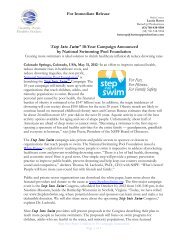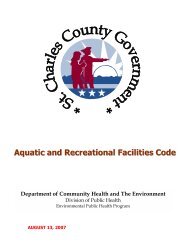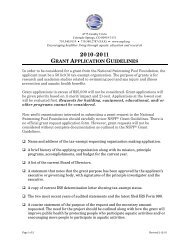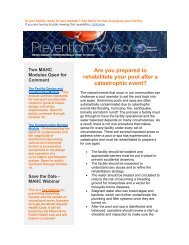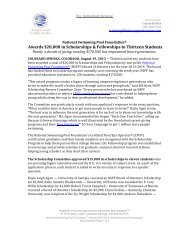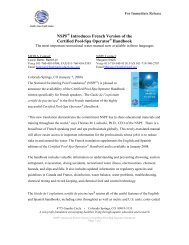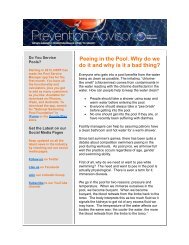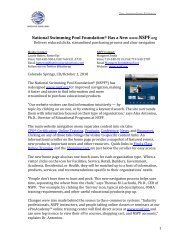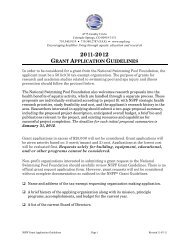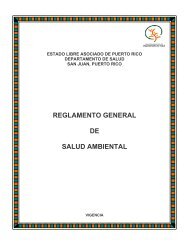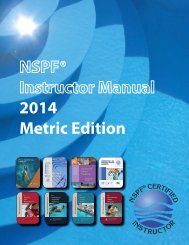- Page 1:
719.540.9119 (Phone) * 719.540.2787
- Page 4 and 5:
FULL CPO ® CERTIFICATION COURSE SC
- Page 6 and 7:
DISCLAIMERThe information furnished
- Page 8 and 9:
CPO ® CERTIFICATION BLENDED COURSE
- Page 10 and 11:
Page 4© 2014 National Swimming Poo
- Page 12 and 13:
Learning requires motivation (willi
- Page 14 and 15:
APPLICATION STAGEIn this stage, the
- Page 16 and 17:
Take deep breaths Use pauses Solici
- Page 18 and 19:
answers. Do some post-course resear
- Page 20 and 21:
Lesson Objectives are the basic goa
- Page 22 and 23:
to follow all National Swimming Poo
- Page 24 and 25:
Page 18© 2014 National Swimming Po
- Page 26 and 27:
Page 20© 2014 National Swimming Po
- Page 28 and 29:
Some areas to consider are: Trainin
- Page 30 and 31:
ENDORSEMENTSNational Swimming Pool
- Page 33 and 34:
The exams contain multiple choice q
- Page 35 and 36:
POST-COURSE CORRESPONDENCEAs soon a
- Page 37 and 38:
Full CPO® Certification Course Out
- Page 39 and 40:
Full CPO® Certification Course Sch
- Page 41 and 42:
Pool Operator Fusion Course Outline
- Page 43 and 44:
Course IntroductionHandbook:Suggest
- Page 45 and 46:
Chapter 1 - Pool and Spa Management
- Page 47 and 48:
Minimizing of legal liability Key f
- Page 49 and 50:
Chapter 2 - Regulations and Guideli
- Page 51 and 52:
Physical dataFire and explosion dat
- Page 53 and 54:
Chapter 3 - Essential CalculationsH
- Page 55 and 56:
Chapter 4 - Pool Water Contaminatio
- Page 57 and 58:
Hypersensitivity Pneumonitis (HP) M
- Page 59 and 60:
Chapter 5 - DisinfectionHandbook: P
- Page 61 and 62:
Key Points: Discuss the use of BCDM
- Page 63 and 64:
Chapter 6 - Water BalanceHandbook:
- Page 65 and 66:
Key Points: Discuss the various asp
- Page 67 and 68:
Chapter 7 - Pool & Spa Water Proble
- Page 69 and 70:
No Product label chemical adjustmen
- Page 71 and 72:
Chapter 8 - Chemical TestingHandboo
- Page 73 and 74:
Follow the specific instructions. E
- Page 75 and 76:
Chapter 9 - Chemical Feed and Contr
- Page 77 and 78:
Chapter 10 - Water CirculationHandb
- Page 79 and 80:
Key Points: Discuss the various asp
- Page 81 and 82:
Chapter 11 - Pool & Spa FiltrationH
- Page 83 and 84:
Homework Assignment: Provide the st
- Page 85 and 86:
Chapter 12 - Heating and Air Circul
- Page 87 and 88:
Chapter 13 - Spa and Therapy Operat
- Page 89 and 90:
Key Points: Discuss water chemistry
- Page 91 and 92:
Chapter 14 - Facility SafetyHandboo
- Page 93 and 94:
NEVER mix chemicals or interchange
- Page 95 and 96:
Chapter 15 - Keeping RecordsHandboo
- Page 97 and 98:
Chapter 16 - Maintenance SystemsHan
- Page 99 and 100:
Chapter 17 - TroubleshootingHandboo
- Page 101 and 102:
Chapter 18 - Facility Renovation &
- Page 103 and 104:
State and Local Code Supplement****
- Page 105 and 106:
Review CalculationsSuggested Time:
- Page 107 and 108:
SECTION 5The Aquatic Play Feature (
- Page 109 and 110:
The Aquatic Play Feature Course Adm
- Page 111 and 112:
PROMOTING THE PROGRAMAs with any NS
- Page 113 and 114:
Aquatic Play Feature Course Outline
- Page 115 and 116:
Chapter 1 - Feature Types & Unique
- Page 117 and 118:
Key Points: Interactive play system
- Page 119 and 120:
Chapter 2 - Water QualityHandbook:
- Page 121 and 122:
CDC recommendations for fecal accid
- Page 123 and 124:
Chapter 3 - Management and Operatio
- Page 125 and 126:
Indoor facilities Refer to material
- Page 127 and 128:
Aquatic Play Feature Supplement (op
- Page 129 and 130:
SECTION 6The NSPF Aquatic Managemen
- Page 131 and 132:
Aquatic Management Series Administr
- Page 133 and 134:
EMERGENCY RESPONSE PLANNINGCOURSE O
- Page 135 and 136: Aquatic Risk Management Course Outl
- Page 137 and 138: Lesson 1 - Aquatic Risk ManagementS
- Page 139 and 140: Lesson 2 - Aquatic Risk ManagementS
- Page 141 and 142: Emergency Response Planning Course
- Page 143 and 144: Lesson 1 - Emergency Response Plann
- Page 145 and 146: Lesson 2 - Emergency Response Plann
- Page 147 and 148: Aquatic Facility Audits Course Outl
- Page 149 and 150: Lesson 1 - Aquatic Facility AuditsS
- Page 151 and 152: Lesson 2 - Aquatic Facility AuditsS
- Page 153 and 154: Recreational Water Illnesses Course
- Page 155 and 156: Chapter 1 - Risk Management for RWI
- Page 157 and 158: Chapter 2 - Microbes and DiseaseCha
- Page 159 and 160: Chapter 3 - Recreational Water Illn
- Page 161 and 162: Chapter 4 - Gastrointestinal Illnes
- Page 163 and 164: Chapter 5 - Dermal RWIsChapter: Cha
- Page 165 and 166: Chapter 6 - Respiratory RWIsChapter
- Page 167 and 168: Chapter 7 - Other Microorganisms an
- Page 169 and 170: Chapter 8 - Methods for Routine Con
- Page 171 and 172: Chapter 9 - Methods for Remedial Co
- Page 173 and 174: SECTION 7The Certified Pool/Spa Ins
- Page 175 and 176: The Certified Pool/Spa Inspector Co
- Page 177 and 178: NSPF Instructors can purchase 10 CP
- Page 179 and 180: Certified Pool/Spa Inspector Course
- Page 181 and 182: Lesson 1 - Introduction and Code En
- Page 183 and 184: Lesson 2 - Operation and Maintenanc
- Page 185: Lesson 3 - DisinfectionHandbook: Pa
- Page 189 and 190: Lesson 5 - Spas, RWIs and Supervisi
- Page 191 and 192: Lesson 6 - Aquatic Play FeaturesHan
- Page 193 and 194: Lesson 7 - Swimming Pool Design Sta
- Page 195 and 196: Certified Pool/Spa Inspector On-sit
- Page 197 and 198: APPENDIXSection ContentsAppendix A
- Page 199 and 200: APPENDIX ANSPF Instructor Web SiteA
- Page 201 and 202: APPENDIX BCPO® Certification Cours
- Page 203 and 204: APPENDIX COn-Site ChecklistRegistra
- Page 205 and 206: APPENDIX DClass Scheduling Guidelin
- Page 207 and 208: APPENDIX FSample Letter - Registrat
- Page 209 and 210: APPENDIX HSample Letter - Congratul
- Page 211 and 212: APPENDIX JCalculation FormulasAMOUN
- Page 213 and 214: APPENDIX LLangelier Saturation Inde
- Page 215 and 216: APPENDIX NChemical Adjustment Works
- Page 217 and 218: APPENDIX PBreakpoint ChlorinationSt
- Page 219 and 220: APPENDIX QCalculations Homework (co
- Page 221 and 222: APPENDIX RBasic Math Skills Test (c
- Page 223 and 224: APPENDIX SNSPF CPO® Certification
- Page 225 and 226: APPENDIX UGeneral Course Record© 2
- Page 227 and 228: APPENDIX VSample Swimming Pool Insp
- Page 229 and 230: APPENDIX WPool and Spa Safety Act C
- Page 231 and 232: APPENDIX XOn-Site Lifeguard Operati
- Page 233 and 234: APPENDIX YIndividual Lifeguard Skil
- Page 235 and 236: APPENDIX ZFacility Audit Form (cont
- Page 237 and 238:
APPENDIX ZFacility Audit Form (cont
- Page 239 and 240:
APPENDIX ZFacility Audit Form (cont
- Page 241 and 242:
APPENDIX ZFacility Audit Form (cont
- Page 243 and 244:
APPENDIX BBSample Facility LayoutCO
- Page 245 and 246:
APPENDIX CCSwimming Pool/Spa Barrie
- Page 247 and 248:
APPENDIX DDElectrical Safety Audit
- Page 249 and 250:
APPENDIX EECourse Business Models a
- Page 251 and 252:
APPENDIX FF2013-2014 NSPF Instructo
- Page 253 and 254:
APPENDIX FF2013-2014 NSPF Instructo



